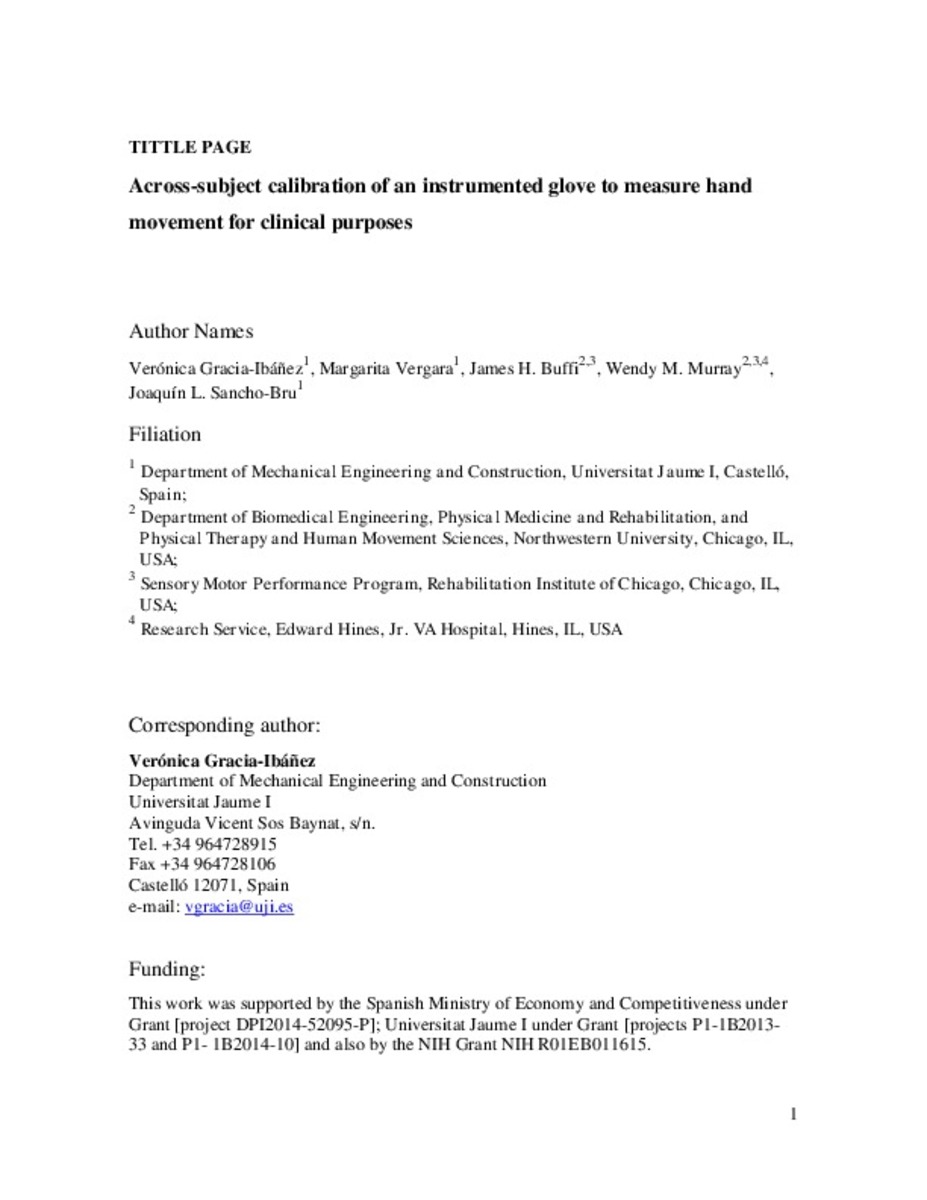Mostrar el registro sencillo del ítem
Across-subject calibration of an instrumented glove to measure hand movement for clinical purposes
| dc.contributor.author | Gracia-Ibáñez, Verónica | |
| dc.contributor.author | Vergara, Margarita | |
| dc.contributor.author | Buffi, James H. | |
| dc.contributor.author | Murray, Wendy M. | |
| dc.contributor.author | Sancho-Bru, Joaquin L. | |
| dc.date.accessioned | 2017-02-01T08:38:47Z | |
| dc.date.available | 2017-02-01T08:38:47Z | |
| dc.date.issued | 2016 | |
| dc.identifier.citation | GRACIA-IBÁÑEZ, Verónica, et al. Across-subject calibration of an instrumented glove to measure hand movement for clinical purposes. Computer Methods in Biomechanics and Biomedical Engineering, 2016, p. 1-11. | ca_CA |
| dc.identifier.issn | 1025-5842 | |
| dc.identifier.issn | 1476-8259 | |
| dc.identifier.uri | http://hdl.handle.net/10234/165775 | |
| dc.description.abstract | Motion capture of all degrees of freedom of the hand collected during performance of daily living activities remains challenging. Instrumented gloves are an attractive option because of their higher ease of use. However, subject-specific calibration of gloves is lengthy and has limitations for individuals with disabilities. Here, a calibration procedure is presented, consisting in the recording of just a simple hand position so as to allow capture of the kinematics of 16 hand joints during daily life activities even in case of severe injured hands. ‘across-subject gains’ were obtained by averaging the gains obtained from a detailed subject-specific calibration involving 44 registrations that was repeated three times on multiple days to 6 subjects. In additional 4 subjects, joint angles that resulted from applying the ‘across-subject calibration’ or the subject-specific calibration were compared. Global errors associated with the ‘across-subject calibration’ relative to the detailed, subject-specific protocol were small (bias: 0.49°; precision: 4.45°) and comparable to those that resulted from repeating the detailed protocol with the same subject on multiple days (0.36°; 3.50°). Furthermore, in one subject, performance of the ‘across-subject calibration’ was directly compared to another fast calibration method, expressed relative to a videogrammetric protocol as a gold-standard, yielding better results. | ca_CA |
| dc.description.sponsorShip | This work was supported by the Ministerio de Economía y Competitividad [project number DPI2014-52095-P]; Universitat Jaume I [project number P1-1B2013-33], [project number P1-1B2014-10]; NIH [grant number NIH R01EB011615]. We thank Marta Mora, PhD, for her collaboration in coding for data glove acquisition, and the graduate student Sheyla Mestre Vicente for her collaboration in data collection. Authors thank also Union de Mutuas for their support in clinical guidance | ca_CA |
| dc.format.extent | 11 p. | ca_CA |
| dc.format.mimetype | application/pdf | ca_CA |
| dc.language.iso | eng | ca_CA |
| dc.publisher | Taylor & Francis | ca_CA |
| dc.relation.isPartOf | Computer Methods in Biomechanics and Biomedical Engineering, 2016 | ca_CA |
| dc.rights | © Taylor & Francis Group | ca_CA |
| dc.rights.uri | http://rightsstatements.org/vocab/InC/1.0/ | * |
| dc.subject | instrumented glove | ca_CA |
| dc.subject | across-subject calibration | ca_CA |
| dc.subject | fast calibration | ca_CA |
| dc.subject | hand movement | ca_CA |
| dc.subject | hand disabilities | ca_CA |
| dc.title | Across-subject calibration of an instrumented glove to measure hand movement for clinical purposes | ca_CA |
| dc.type | info:eu-repo/semantics/article | ca_CA |
| dc.identifier.doi | http://dx.doi.org/10.1080/10255842.2016.1265950 | |
| dc.rights.accessRights | info:eu-repo/semantics/openAccess | ca_CA |
| dc.relation.publisherVersion | http://www.tandfonline.com/doi/full/10.1080/10255842.2016.1265950?scroll=top&needAccess=true | ca_CA |
Ficheros en el ítem
Este ítem aparece en la(s) siguiente(s) colección(ones)
-
EMC_Articles [808]







